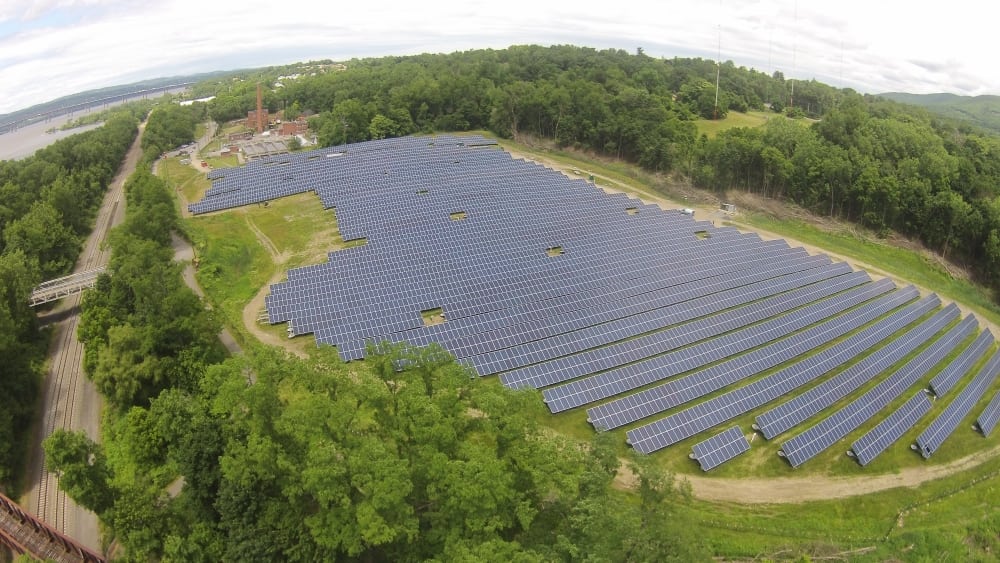Former landfill will save city $100,000 annually
By Jeff Simms
A solar power farm at the former Beacon landfill near Dennings Point should be operational next month, saving the city as much as $100,000 annually in electricity costs.
The 20-acre site, used first illegally and then as a municipal dump before the state Department of Environmental Conservation closed it in 1977, is now home to 8,500 solar panels stationed on steel girders and tilted 25 degrees toward the south, where they’ll get the most sun throughout the year. It is expected to produce 2 megawatts of energy annually, the equivalent of what is used by about 1,600 homes.
“This is no different than what you might install on your home — there’s just a lot more of it,” said Paul Curran, the managing director of BQ Energy, a Wappingers Falls firm selected by the city in 2016 to build and operate the array. “It’s a good use of this land, to generate renewable energy for city use. There’s really no downside.”

The power produced by the panels will be routed through some 80 inverters to Central Hudson. BQ Energy, which has a 25-year lease on the site, will then sell the credits earned from the utility to the city at a discount.
“In simple terms, we’ll generate a negative power bill at the landfill,” explained Curran. “The credits can be used by the city to offset other power bills, such as for street lights.”
That could be a big savings. Lighting is often the largest portion of a city’s electricity costs, and according to the state Public Service Commission, Beacon’s 1,500 streetlights account for about 40 percent of its annual electricity bill.
“Where that will translate to residents will be in their taxes,” said City Administrator Anthony Ruggiero. “Residents won’t see it on their utility bills, but the savings will be in our energy costs, and we can pass that on.”

After BQ Energy was awarded the project, called Sunlight Beacon, it took the company about a year to construct the facility. It took another year for the state Public Service Commission, which regulates utilities, to approve the request by the company and Beacon to use the credits toward the cost of streetlights.
The project is the first of its kind in Dutchess County. In 2014, BQ Energy, which has constructed similar facilities throughout the Northeast and as far away as the Netherlands, built a solar farm at a former landfill in Patterson. Its credits are sold to the private Trinity-Pawling School.
Curran says former landfills are ideal for solar farms because they are difficult to adapt to other uses. At the Beacon site, dozens of pipes still protrude from the ground in and around the solar array to release methane created by rotting garbage below the surface.
“It’s not exactly a tourist area,” he quipped.

I’m not the first person to suggest this, but wouldn’t this be a great use for the former Marathon property in Cold Spring?
Covering the former Marathon Battery site with solar panels is a terrible idea. The Marathon site has been mostly cleaned up (see the EPA’s five-year reports for details). It is close to Cold Spring’s Metro North station and Main Street businesses. Properly developed, with a mixture of residential and commercial uses, and with sensitivity to the village’s historic character, the site could contribute greatly to Cold Spring’s tax base and affordable housing. If we want to avoid the consequences of suburban sprawl, we’ll need to be practical and reasonable about making use of existing infrastructure (the village’s water and waste treatment facilities could easily handle the additional uses). I would urge the Cold Spring Code Update Committee to specifically prohibit using Marathon as a solar farm.
I disagree with Michael’s assessment of the Marathon solar farm suggestion as “a terrible idea.” While the arguments he presents are sound, the essentially unsolvable problem of vehicular access to Marathon means his New Urbanist vision is unlikely to be realized.
There are at least two realistic ways to engineer access to the Marathon site. The challenges for both are political. The first way would be to convert Forge Gate Drive into a public road, which the Village of Cold Spring can do by a simple majority vote of its board. The second method would be to link Lunn Terrace with the Boulevard, perhaps in conjunction with additional Metro North parking east of the Cold Spring Station. I prefer the second, but either would provide for the access Peter Henderson says is an “essentially unsolvable problem.”
What was the cost of building this facility and what is the yearly cost for maintenance and management?
Done by a private solar company that leases the land. Great re-use of a capped landfill that you can’t do much else with.
Central Hudson is a fixed-cost center. Any loss of revenue or credits to the city will have to be recovered elsewhere. In other words, rates will be raised, and unless you live in Beacon, you’ll see no relief to your taxes. Thanks for nothing.
Currently privately owned…!
With the closing of Indian Point and the never-ending increased need for energy, this is a huge accomplishment regardless of the amount of money saved. The fact that some people are searching for a reason to make this a negative is mind-boggling. We need many more projects like this.